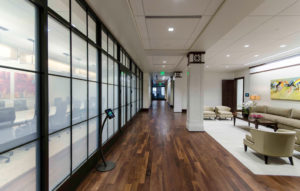Interior Design that Encourages Collaboration in the Corporate Environment
-
Category
Studio-Workplace, Innovation -
Posted By
Laura Hardin -
Posted On
Feb 23, 2016
When planning for corporate environments, the color of the walls and pattern of the carpet are important but not nearly as critical as creating an environment that encourages collaboration. Two main styles of collaborative spaces should be considered.
- Laid-back Lounge
Comfortable areas in business offices are trending within the interior design world. By using sofas, ottomans and smaller tables in place of the typical desk and chair, employees can feel more at home. Kicking back and propping your feet up for a casual meeting with a few colleagues can allow for creative juices to flow more naturally. Including a lounge-style setting in the workspace, breaking up the traditional use of cubicles and offices, is also more appealing to the younger employees. Millennials gravitate toward an open concept space because it meets their need for social interaction while brainstorming business ideas. Playful pops of color, patterns and use of different textures help bring the space together. Legos, writable furniture surfaces, and moveable furniture allow employees to interact with their environment. This type of collaboration setting naturally works for businesses like marketing agencies, sales-focused businesses and design firms — but should also be considered as an option for meeting spaces for much more traditional professionals.
- Flexible Structure
If designing for a more formal office setting, an enclosed conference room may be more accommodating for serious meetings. Employees may need to spread out papers, take notes on their laptops, or shut the doors for a call. While a large, wired work surface and more traditional work chairs may be more appropriate in these spaces — productivity can be enhanced through technology integration, operable partitions and a variety of display options including writeable wall surfaces, multiple monitors and accommodations for video conferencing. This type of collaboration setting works meetings where formal presentations are necessary.

Barnes & Thornburg Conference Space
It is not uncommon to see a mixture of lounge and flexible structure settings worked into the interior design of an office. Both of these styles do require the element of flexibility in order to function properly. In both, employees need to be able to move the furniture around and customize the use of the pieces to best fit the function of the meeting.
Consideration of multiple types of different collaborative spaces can help your client function more effectively and feel at home in their office space.







